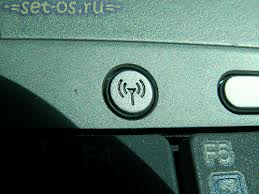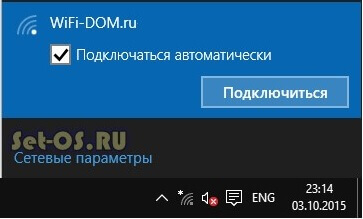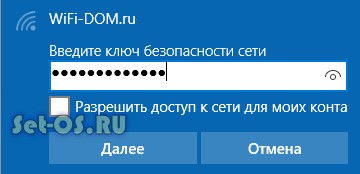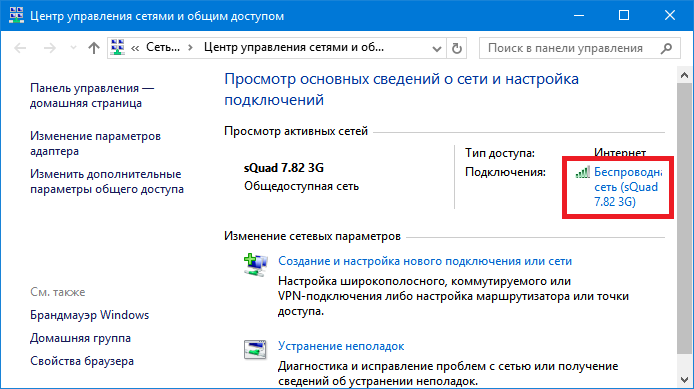Setting up a wireless connection in Windows 10. Changing the adapter settings to launch a virtual network. If WiFi doesn't work
Without a doubt the way out new version popular operating system became one of the main events of 2015 in the field of IT technologies. Following months, which for many users felt like an eternity, a flurry of criticism, discussions and questions followed. Of course, most users, after installing the update, rushed to check what they had added to the main functions of the “ten”. Of course, one of the main functions of the OS is connecting to wireless network Internet. Overall, something extraordinary in Wi-Fi work the creators did not implement it. In addition, many similarities in this component can be found with a similar process in its predecessor versions. But, as you understand, this would not be a new OS if the functions and settings were left without innovations compared to Windows 7 and 8. Today we will talk about benefits of Wi-Fi and how to connect Wi-Fi on Windows 10.
New Wi-Fi features in Windows 10
IN general outline, this element got a modified panel for connecting to wireless networks. In particular, inclusion and turning off Wi-Fi can be done in two clicks.
What we can praise the developers for is the integration of such an option as automatic installation all drivers.
Availability of radio module wireless communication, or as it is commonly called, a WiFi adapter is a mandatory requirement for modern laptop. I think that if a laptop were produced without it now, its popularity would be extremely low, because almost every third apartment already has a wireless network. But having bought modern computer, a novice user may encounter some difficulties, because, despite all the friendliness of modern operating systems Windows systems, you still need to know “what and how to press.” Especially for beginners, today I will tell you how to enable and configure Wi-Fi on a laptop with Windows 10.
In order to set up a connection between a Windows 10 computer and a wireless WiFi networks, you need to start by checking whether it is turned on LAN card or not. On the laptop for work wireless adapter WiFi responds special button. On older laptops, this can be done using this sliding slider on the side of the case.
Like this:


Like this:

And even something like this:

As you can see, they all have the inscription “Wireless”.
On newer ones, there was a separate button above the keyboard (usually somewhere next to the device’s power key). It looks something like this:

Or like this:

On modern laptops, the Wi-Fi power button is combined with one of the function keys- F1-F12. Most often it is F2, F5 or F12:

Look carefully - the antenna is shown in blue:

For it to work, you must first hold down the Fn button (it is located at the bottom of the keyboard, near Ctrl keys) and, holding it, press the Wi-Fi power button.
So, half the battle done. Remains only connect laptop to Wi-Fi network.
By the way, for some reason many people call it Fi-Fi, but at the same time they call the router - Fi-Fi router 🙂 - this is wrong.
On the taskbar, next to the clock, find the network icon. It can be in the form of a monitor (cable connection) or in the form of a signal reception scale (for WiFi).

Click on it with the left mouse button and in the menu that opens, select the item “ Network settings" The following window will open:

Here (only on laptops) you need to check that the “Wireless Network” switch is in the “On” position.
Below, find the item “Manage Wi-Fi network settings” and select it:

Here you need to disable the items “Connect to suggested hotspots” and “Connect to networks shared by my contacts.” This is done to prevent your laptop from leaking network connection data to contacts from Outlook, Skype or Facebook using technology WiFi Sense.
Let's go back and see the list of networks available for connecting to the laptop:

You can connect to the one you need directly from here, or you can close this window and click on the Wi-Fi icon again near the clock. A menu will open with the same list:

Select the one you need and wait for the “Connect” button. If it is protected, it will ask you for a password:

If the entered key is correct, the laptop will connect to the Wi-Fi network without problems and you can then check Internet access.

If suddenly the system freezes in obtaining an IP address, or receives it, but there is no access to the Internet, although other clients work without problems, then most likely there is a problem with setting up the TCP/IP protocol. This article will help you figure this out -. Although, in most cases, all parameters are configured automatically.
Connect to WiFi, on a laptop or computer under Windows control 10, very simple.
In the tray, on the "Network" icon, click on left button mice:
Note. If the network icon in the tray looks different
 this means you don't have WiFi adapter oh, or it's disabled. See the section at the end of this article.
this means you don't have WiFi adapter oh, or it's disabled. See the section at the end of this article.
A panel with a list will open available WiFi networks (access points). You need to click on the network you want to connect to.


After this, the “Connect” button will appear:

After this, a field will appear in which you need to enter the password for this access point: Note
. In order to see the text of the password that you wrote, you need to click the "Eye" button at the right end of the field. The password text is only displayed when the button is held down! Enter the password, click “Next” and if the password is correct, then in half a minute or a minute the connection will be established. The network icon in the tray will change its appearance. In this case, all parameters, except the password, for the new Windows connections
10 will install automatically. After connecting to the point Windows access

10 will prompt you to assign the type of this network:
If you click the "Yes" button, then you can exchange files and other resources on this network (for example, print over the network). If you click the "No" button, then this network will only have the Internet.

The connection is established and you can use the Internet:
How to Change WiFi Settings on Windows 10 In the tray, on the "Network" icon, click on right button

mouse and then select "Network and Sharing Center" from the menu

In the Network Control Center, you need to click on the connection name (in the illustration it is “Wireless network sQuad 7.82 3G”:

The status window for this connection will open, in which you need to click the “Wireless Network Properties” button:

And after that a window will open in which you can change the settings for this connection:
How to use WiFi
Using WiFi is very easy. Once you have created a connection, you can turn it on and off through the network icon in the tray. However, you need to understand that the ability to use WiFi is highly dependent on external factors. Because the radio signal is affected by the external environment. Various obstacles such as walls, ceilings, floors weaken both the signal of the access point and the signal of the client device. Windows shows the signal strength from the access point in “sticks”. The pictures at the beginning of the article show the signal level of one or two short sticks. This is very weak signal
There are programs that show the signal level in numbers - dBm, for example 60 dBm or 40 dBm. The higher the number, the weaker the signal - a good signal is a number less than 50 dBm. However, you need to understand that the accuracy of such numbers varies depending on the adapter and the driver of this adapter. Under the same conditions, one adapter may show, for example, 71 dBm, and another adapter 82 dBm.
In addition to passive barriers, the quality of WiFi signal transmission can be negatively affected by sources of electromagnetic radiation.
So, even if you have the best WiFi adapter installed on your laptop, this does not mean that you will always be able to use the Internet via WiFi. In a situation with bad signal Using an adapter with an external antenna may help. For example USB WiFi TP-Link adapter
TL-WN722N/C is equipped with an external antenna. Moreover, it is removable and, if necessary, can be replaced with another one with a higher gain. What does presence give external antenna
- ? Continuing the same example - under equal conditions - the same access point, the same time and place of connection, the presence of passive barriers between the access point and the client - as a result, a weak signal in both directions:
- The internal "native" WiFi adapter of the laptop connects to the access point, but practically does not provide the ability to use the Internet due to low speed and frequent interruptions.
TP-Link TL-WN722NC with its own antenna provides a stable Internet connection at a good speed.
If WiFi doesn't work
- If your computer does not have a "Wireless Network Connection" the reason may be as follows:
- There is no WiFi adapter on your computer at all. You can find this out through Device Manager. There should be a wireless network card in the list of devices. On your computer WiFi There is an adapter but it is disabled. For example, many laptops have buttons to turn off the WiFi adapter. This can be a separate button or one of the F buttons in combination with the Fn button. If the WiFi adapter is built into motherboard
- , it can be disabled in the BIOS.
- There is an adapter, but no drivers are installed for it, in this case it will be in the list of devices as an unidentified device.
There is an adapter, but it is disabled by software.

There is no WiFi adapter in the list of devices:

There is a WiFi adapter in the list of devices, but it is disabled (icon in front of the adapter name): If "Wireless" network connection "there is, it shows list of networks but can't connect to the desired network
- The signal between your adapter and the access point is too weak. Long distance, thick walls, etc. Moreover, the signal level of the access point may be decent, but the signal from your adapter does not reach the access point. Because the adapter signal is generally weaker than the access point signal. Especially if the adapter is built-in, such as in a laptop.
- You entered wrong password. This is especially true for Windows XP because the password characters cannot be seen there.
If the connection to the access point is established, but the Internet does not work, then the reasons may be:
- WiFi router (access point) is not connected to the Internet. For example, a technical failure at the provider, or a lack of funds in your account with the provider.
- The technical error at work DNS servers at the provider.
Private WiFi network
WiFi Security
Since when using WiFi all information is transmitted via radio waves, which makes WiFi networks much more vulnerable compared to wired networks. The fact is that the radio signals sent by the access point (WiFi router) and devices that are connected to the access point are available for interception by any similar device that is within the “hearing” radius of the access point or from the client of this access point. That is, interception network traffic becomes very simple, accessible and invisible. And intercepting network traffic allows you to collect the information necessary to attack a WiFi network. As more and more access points become available, WiFi increases and so does the number of people willing to “hack” the WiFi network.
The most common motivation for hacking points WiFi access This internet connection via WiFi is free. A fairly common picture today is that you have a WiFi router installed in your apartment and not only your devices are connected to it, but also the computer of one of your neighbors. You pay for the Internet, and your tech-savvy neighbor gets the Internet for free.
But Internet “theft” is not the only reason why WiFi networks are “hacked.” The fact is that if an attacker gains access to your access point, through it he can gain access to all devices that are connected to your WiFi router. And this gives him the opportunity to steal your personal data. For example, passwords to mail, to Internet banking, your documents - in one word, to everything you own.
Therefore, you need to use WiFi with caution. Here are a few rules to follow.
Do not connect to open public WiFi networks through the laptop on which you store valuable information. And if you need access to the Internet via open networks WiFi, then use a firewall and antivirus on your laptop. It’s even better if you install two operating systems on your laptop. One main one, in which all your valuable information will be stored. And the other is empty, only for accessing the Internet through open WiFi networks.
If you are using WiFi router at home or in the office, you must correctly perform WiFi setup router:
- Use WPA2 security type.
- The password for protection should be long - preferably 10 - 15 characters, and should consist of an arbitrary set of characters. Password marina1234 very bad - it will be hacked in a few minutes. Password
